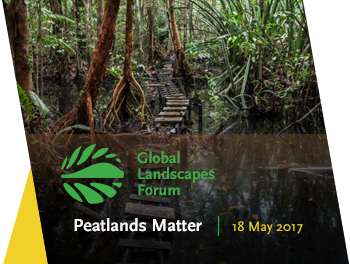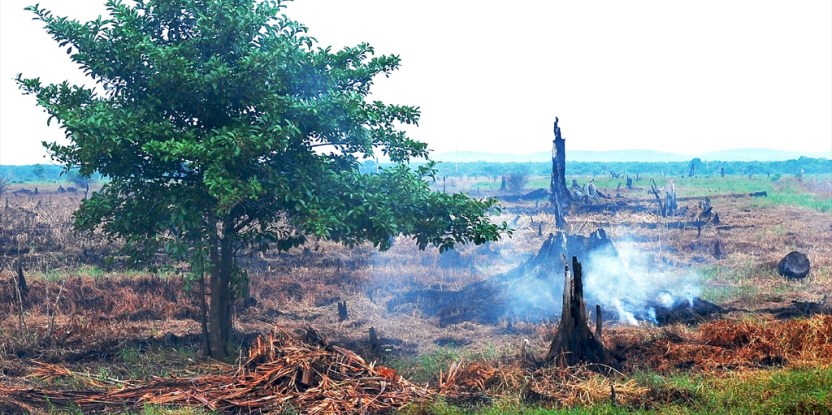With 425 people in attendance in Jakarta — as well as over one thousand views of the event livestream and 5 million people reached through Twitter — the thematic Global Landscapes Forum: Peatlands Matter event brought together local and global actors to accelerate positive action in the management of peatlands around the world.
Tim Christophersen, Senior Programme Officer of Forests and Climate Change for UN Environment, spoke to Forests News’ Editor-in-Chief Leona Liu about the current challenges for countries to fully leverage the power of peatlands in their climate change mitigation and adaptation strategies.
UN Environment participated in the Forum’s afternoon science session, The rediscovered carbon stocks in tropical wetlands and peatlands, organized by the Center for International Forestry Research (CIFOR). The panel discussed the latest tools for identifying and locating wetlands and peatlands, and revealed how scientists are reassessing carbon stocks.
“Many countries don’t know where [peatlands] are in the Climate Convention,” said Christophersen. “We’re only now starting to have that knowledge. UN Environment will put out a Global Rapid Response Assessment later this year on peatlands that will be followed next year by a more in-depth scientific global assessment on peatlands that will hopefully help all countries to answer the following questions: Do we have peatlands? Where are they? How big are they? How much carbon is there? What can be done to protect them?
*Read the full transcript of the TV interview below
What is the importance of peatlands? How do they figure into climate change adaptation and mitigation strategies and broader development goals?
Peatlands are fascinating ecosystems. They are found in 180 countries, so there’s probably one near you wherever you might be. They are one of the least understood ecosystems. We’ve only recently seen that they have enormous carbon storage. Basically, for thousands of years, organic matter has accumulated. So for the climate, there is an enormous potential to keep that carbon in the ground and continue to sequester, or serve as a carbon sink.
Peatlands comprise only about 3 percent of the world’s surface area, but are probably responsible for 5 percent of all greenhouse gas emissions. If we can plug that leak, it would probably give us enough leverage to reach the target of the Paris Agreement to stay within 2 degrees of global warming. If we can’t plug that leak of peatland fires and peatland degradation, it might be very difficult to stay within safe limits and stay within the Paris Agreement target.
Are the countries that already have REDD+ schemes in place fully leveraging the potential of peatlands for climate change mitigation and adaptation?
Not yet. For example, Indonesia has a forest reference emission level under the Climate Convention to measure how many emissions they have and how they want to reduce them, but it does not take into account the peat store or the fires that are burning on peatlands.
The same situation is happening in many other countries where peat is not yet included in those efforts, but we’re seeing a change now. Countries are more alert to the possibilities and the challenges [of peat].
That’s why [UN Environment] formed the Global Peatlands Initiative, which brings together more than 20 international organizations and countries like the Congo Basin countries, Peru, and Indonesia to look at how peatlands can be better integrated into their Sustainable Development goals and into the climate efforts that are being undertaken.
Tell me a bit more about the initiative you’ve just mentioned. I understand that it was actually launched at another Global Landscapes Forum event?
That’s right, in Marrakesh. We launched it only last year, in November 2016. And now we have over 20 partners. We aim to better harmonize all the data and the support that the international community can give to countries like Indonesia and the Republic of Congo, and through that, we hope to also sensitize policymakers (ministers of environment, ministers of finance, ministers of planning) to the fact that peatlands are probably the most important terrestrial ecosystems for the fight against climate change.
Peatlands are probably the most important terrestrial ecosystems for the fight against climate change.
What are some of the challenges for countries to fully leverage the power of peatlands?
First of all, many countries don’t know where [peatlands] are in the Climate Convention. Many years ago in 2006, in Kenya, climate negotiators tried to bring peatlands into the discussion, but some countries said, ‘Well, we don’t have peatlands’, including the host country Kenya. And yet, five kilometers outside of the convention venue there were lots of peatlands, so there was no knowledge as to where those peatlands were.
We’re only now starting to have that knowledge. [UN Environment] will put out a Global Rapid Response Assessment later this year on peatlands that will be followed next year by a more in-depth scientific global assessment on peatlands that will hopefully help all countries to answer the following questions: Do we have peatlands? Where are they? How big are they? How much carbon is there? What can be done to protect them?
So the first point is that [countries] don’t know that there are peatlands. The second point is that in many cases- and Indonesia is really the country that is the most important country for this topic right now- many of these areas are under agricultural production. They used to be peatlands, but now they are often drained and there are plantations and agricultural fields on them. And the fire problematic that we see in Indonesia is largely due to this drainage of peatlands.
What do you hope to achieve with this Global Landscapes Forum here in Jakarta? What are some takeaways you’d like to have at the end of the day?
Well, I think the motto of this event- ‘Peatlands Matter’- which is also the hashtag that is now all over Twitter, is the core of the message we want to bring to policymakers.
Peatlands do matter for the climate, but also for development. These are millions of hectares of land in many tropical countries. There are millions of people who depend on them for their livelihoods. In some cases, they are overused, overexploited, managed badly, or drained too deep that the water table falls too low. We have to turn the tide around and make sure peatlands are successfully managed.
Here at the Global Landscapes Forum, we are hearing many successful examples of how that can be done. We would like to bring [these examples] to other countries- some of which are here today, and some of which are not. We would like to use the Global Landscapes Forum to really elevate this topic on the international policy agenda.
*This is part of a series of video interviews from the 2017 Global Landscapes Forum: Peatlands Matter thematic event in Jakarta, Indonesia
We want you to share Forests News content, which is licensed under Creative Commons Attribution-NonCommercial-ShareAlike 4.0 International (CC BY-NC-SA 4.0). This means you are free to redistribute our material for non-commercial purposes. All we ask is that you give Forests News appropriate credit and link to the original Forests News content, indicate if changes were made, and distribute your contributions under the same Creative Commons license. You must notify Forests News if you repost, reprint or reuse our materials by contacting forestsnews@cifor-icraf.org.


